Flaws 'could potentially lead to the exposure of sensitive or confidential user information during transactions,' according to new report from Cenzic

The number of software vulnerabilities detected has risen to the point that almost 9 out of 10 Web applications have flaws that could lead to the exposure of sensitive information.
Cenzic's "Web Application Security Trends Report Q1-Q2, 2009" report, released on Monday, says that more than 3,100 vulnerabilities were identified in the first half of the year, 10% more than the number identified in the second half of 2008.
Of the vulnerability total, 78% were Web application vulnerabilities, lower than in the second half of 2008 but higher than in the first half of last year.
The SANS Institute's Top Cyber Security Risks report, released in September, found that over 60% of attack attempts on the Internet target Web applications.
Ninety percent of the Web application vulnerabilities were in commercial Web apps and 8% were the browsers that run Web apps, Cenzic's report says.
The makers of the software affected by the top ten vulnerabilities include PHP, SAP (NYSE: SAP), Sun, Citrix (NSDQ: CTXS), Apache, F5 Networks, Symantec (NSDQ: SYMC), and IBM (NYSE: IBM).
Cenzic says that SQL Injection and Cross Site Scripting vulnerabilities played a role in 25% and 17% of all Web attacks respectively.
Cenzic's report claims that 87% of the analyzed Web applications "had serious vulnerabilities that could potentially lead to the exposure of sensitive or confidential user information during transactions."
In the second quarter of 2008, that number was 78%.
In terms of browser vulnerabilities, Firefox and Safari led the pack, and Google (NSDQ: GOOG) Chrome was conspicuously absent.
"Mozilla Firefox had the largest percentage at 44%," the report says. "What was surprising was that the Safari browser had a lot more vulnerabilities at 35% this time around mainly due to vulnerabilities reported in iPhone Safari. Internet Explorer was third at 15% and Opera with 6% of total browser vulnerabilities."
In recent years, Mozilla's Firefox has tended to have a higher number of vulnerabilities than Internet Explorer, but Firefox bugs have been fixed more quickly than those affecting Internet Explorer. Thus, Mozilla has argued that the number of days that users were vulnerable represents a more useful security metric than a comparison of vulnerabilities.
Members of the Firefox team have also argued that the security of Firefox and Internet Explorer can't easily be compared because Mozilla's security process is open andMicrosoft (NSDQ: MSFT)'s is closed.
Mozilla's Johnathan Nightingale offered a comment along these lines via e-mail. "The Cenzic report seems to measure security by overall bug count, and we've been pretty vocal about why that's a flawed metric," he said. "We've even seen signs lately that Microsoft is coming around on the subject -- in a recent interview Steve Lipner talked about not measuring the success of Microsoft's SDL by gross bug counts was refreshing to see."
A Microsoft spokesperson wasn't immediately available for comment. The company has cited its Security Development Lifecycle as a reason for the declining number of vulnerabilities in its products.
Nightingale adds that Cenzic's report puts much of the blame for browser bugs on plugin software, which Mozilla has been trying to improve through a recently launched plugin check service.
InformationWeek has published an in-depth report on new software models. Download the report here (registration required).
About the Author(s)
You May Also Like
Securing Code in the Age of AI
April 24, 2024Beyond Spam Filters and Firewalls: Preventing Business Email Compromises in the Modern Enterprise
April 30, 2024Key Findings from the State of AppSec Report 2024
May 7, 2024Is AI Identifying Threats to Your Network?
May 14, 2024Where and Why Threat Intelligence Makes Sense for Your Enterprise Security Strategy
May 15, 2024
Black Hat USA - August 3-8 - Learn More
August 3, 2024Cybersecurity's Hottest New Technologies: What You Need To Know
March 21, 2024




